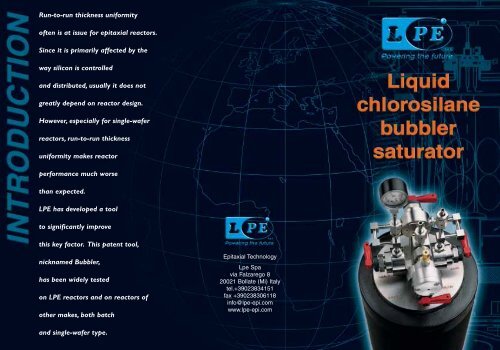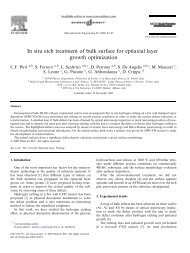Bubbler brochure - LPE Spa
Bubbler brochure - LPE Spa
Bubbler brochure - LPE Spa
You also want an ePaper? Increase the reach of your titles
YUMPU automatically turns print PDFs into web optimized ePapers that Google loves.
Run-to-run thickness uniformity<br />
often is at issue for epitaxial reactors.<br />
Since it is primarily affected by the<br />
way silicon is controlled<br />
and distributed, usually it does not<br />
greatly depend on reactor design.<br />
However, especially for single-wafer<br />
reactors, run-to-run thickness<br />
uniformity makes reactor<br />
performance much worse<br />
than expected.<br />
<strong>LPE</strong> has developed a tool<br />
to significantly improve<br />
this key factor. This patent tool,<br />
nicknamed <strong>Bubbler</strong>,<br />
has been widely tested<br />
on <strong>LPE</strong> reactors and on reactors of<br />
other makes, both batch<br />
and single-wafer type.<br />
Epitaxial Technology<br />
Lpe <strong>Spa</strong><br />
via Falzarego 8<br />
20021 Bollate (Mi) Italy<br />
tel.+39023834151<br />
fax +390238306118<br />
info@lpe-epi.com<br />
www.lpe-epi.com
The <strong>Bubbler</strong> cylinder is filled with liquid<br />
Chlorosilane to about 70%, while the remaining<br />
space is the expansion space for overlying vapor.<br />
During deposition, liquid level changes a few<br />
centimeters, so that carrier gas saturation and<br />
mixture ratio suffer negligible changes.<br />
Higher stability of liquid temperature is given by a large<br />
heat-exchange surface and by a water jacket.<br />
Usual water temperature ranges 18 to 25°C.<br />
Correct temperature values depend on<br />
specific process requirements.<br />
It is highly recommended to provide water<br />
with temperature variation < +/- 1°C.<br />
Therefore, for a given set-point, the relevant silicon<br />
amount delivered to reactor is extremely constant.<br />
For further care, liquid Chlorosilane is not refilled<br />
during deposition or vent step, but is controlled by a purge<br />
valve of reactor (usually the hydrogen purge valve)<br />
through the Control Box, so as to prevent<br />
prejudicing saturation parameters during deposition.<br />
All this ensures higher, time-tested process reliability.<br />
CONTROL BOX FOR<br />
AUTOMATIC REFILLING (*)<br />
Two Control Box models are available:<br />
for single and dual-station reactors.<br />
The Control Box is a separate controller which<br />
monitors the Chlorosilane level in the <strong>Bubbler</strong> and,<br />
through a signal from the reactor, performs<br />
<strong>Bubbler</strong> refilling.<br />
<strong>Bubbler</strong> refilling is not allowed during<br />
deposition or vent step prior to deposition.<br />
Refill is made by pressurizing the main<br />
Chlorosilane tank at 0.5-1.5 bar pressure;<br />
the liquid is forced to the <strong>Bubbler</strong> through<br />
a pneumatic valve actuated by the liquid<br />
level sensor in the <strong>Bubbler</strong>, and by the<br />
Control Box, until level is restored.<br />
A separate safety level sensor shuts off the<br />
pneumatic valve in the event of<br />
main sensor malfunctioning,<br />
and activates a sound alarm.<br />
Also when failing to achieve refill level<br />
(main tank empty), a sound alarm will<br />
warn the operator.<br />
(*) The Control Box is supplied only for<br />
application to reactors not manufactured by <strong>LPE</strong>.<br />
In <strong>LPE</strong> reactors, <strong>Bubbler</strong> functioning logic<br />
is integrated in the reactor software.<br />
Two bubbler models are available:<br />
Standard and Minispeed.<br />
• the Standard bubbler (14 liters capacity)<br />
has been designed for high growth speed<br />
( approx. 20 to 60 grams per minute of Chlorosilane with<br />
approx. 25 liters/minute of H2 carrier)<br />
and long deposit process.<br />
• the Minispeed bubbler (4 liters capacity)<br />
better fits low and very low growth speed applications<br />
(approx. 2 to 15 grams per minute of Chlorosilane<br />
with approx. 8 liters/minute of H2 carrier)<br />
because of low dead vapor volume and fast stabilization.<br />
Chlorosilane capacity at refill level (approx. values)<br />
std - TET std - TCS mini - TET mini - TCS<br />
liters 14.3 14.3 4.15 4.15<br />
Kg 21 19 6 5.5<br />
Liquid level variation<br />
figures in mm/min.x gram of chlorosilane output<br />
std - TET std - TCS mini - TET mini - TCS<br />
0.0353 0.0387 0.1228 0.1346<br />
Example<br />
Process requires 28.0 grams/minute TET for 15 minutes<br />
(+ 1 minute pre-purge ) - bubbler std. Model.<br />
Level decrease at the end of process will be.<br />
==> 0.0353 x 28 x 16 = 15.8 mm<br />
Please contact <strong>LPE</strong> to decide the best fit for your application.<br />
CONSTRUCTION<br />
Materials: AISI 316 electropolished for parts in<br />
contact with gases or liquid<br />
Connections: VCR<br />
Welding: Orbital<br />
DIMENSION AND WEIGHT<br />
<strong>Bubbler</strong><br />
Std model<br />
Minispeed<br />
model<br />
overall<br />
(mm)<br />
210 x 210 x 1230 h<br />
160 x 160 x 1230 h<br />
inside<br />
(mm)<br />
dia 155 x 990h<br />
dia 83 x 990h<br />
weight Kg<br />
(empty)<br />
Control Box<br />
150 w x 230 l x 150 h mm , weight 2 Kg<br />
Note: the Control Box can be located up to 15 meters<br />
away from bubbler<br />
34<br />
16




